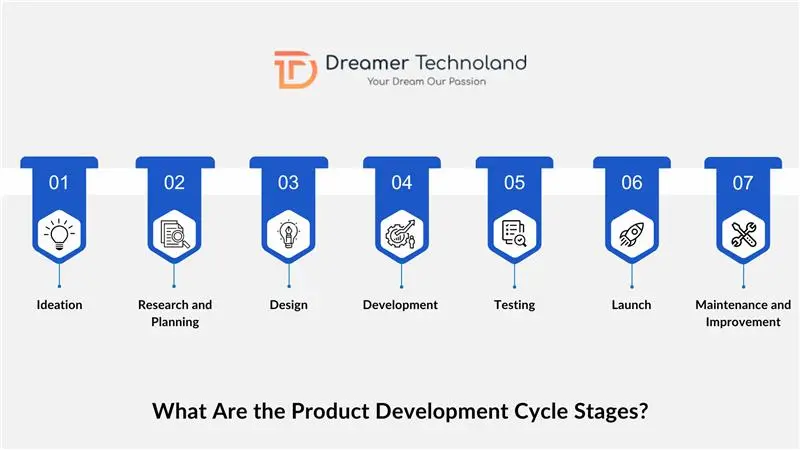Software development doesn’t begin with code and doesn’t end with deployment. Every digital product that meets real-world needs goes through a journey. The product development strategy is known as the product development life cycle in the digital world. Whether building a new mobile app or improving an existing platform, understanding this life cycle helps developers see the bigger picture. More than just a process for managers or product owners, it deeply influences the day-to-day decisions made in code. Embracing it means building smarter, collaborating better, and delivering more value. In this blog, we will uncover the concept of the product development life cycle, understand why it is crucial, break down its key stages, and explain why every developer should care about it.
Understanding the Product Development Life Cycle
The product development life cycle (PDLC) is a structured roadmap that outlines the journey of a product from its initial concept to its retirement. It serves as a bridge between ideas and execution, connecting creative vision with practical development. Each phase of the cycle represents a step forward in turning thoughts into functioning, valuable software. For developers, knowing how a product moves through each stage allows for better alignment with goals, deadlines, and customer needs. It also helps with anticipating future updates, minimizing rework, and planning resources efficiently.
Rather than viewing development as an isolated coding task, the PDLC highlights its interdependence with research, planning, testing, and feedback. It defines how teams collaborate, how decisions are made, and how risks are managed. A strong grasp of this cycle improves communication between developers and other stakeholders, such as designers, testers, and business leaders. Understanding the product journey from end to end ensures better decisions are made not only at the keyboard but throughout the development process.
Why is the Product Development Life Cycle Crucial?
A well-structured product development life cycle can mean the difference between a successful launch and a costly failure. It brings order to what could otherwise be a chaotic process. By following a sequence of defined stages in the new product development process, teams can anticipate potential issues, allocate resources wisely, and avoid duplication of effort. Each phase helps validate that the product is on the right path, minimizing the risk of wasted time or effort on features no one needs.
For developers, this clarity helps in understanding what needs to be built, when it needs to be delivered, and why it’s important. Without this framework, developers might build solutions based on assumptions instead of real customer needs or business goals. That often results in rework, delays, or even product failures. In contrast, a clear life cycle streamlines development and ensures that every line of code supports a larger objective.
Moreover, the life cycle helps identify technical debt early. When developers are involved in the full cycle, they get the opportunity to voice potential issues with feasibility or scalability at earlier stages. This saves future development hours and builds more sustainable products.
What are The 7 Stages of the Product Development Process?
The product development life cycle is typically broken into seven stages. Each one serves a specific purpose and involves unique challenges and decisions. Below are the stages of the product development life cycle.

Ideation
The journey begins with an idea. This spark could solve a problem or meet a new market demand. During this phase, teams brainstorm and evaluate different product concepts. Stakeholders conduct preliminary research to identify gaps, opportunities, and potential competitors. Developers often play a role here by offering technical insights on feasibility and innovation. Understanding what’s technically possible helps shape more realistic and achievable ideas. Early developer input ensures that big ideas are grounded in technical reality while still allowing space for creative thinking.
Research and Planning
Once a promising idea has been selected, it’s time to lay the groundwork. It involves in-depth research into user needs, market trends, and potential technical approaches. Planning also includes defining goals, timelines, and resource requirements. Developers benefit from this phase by gaining clarity on the product’s purpose, audience, and scope. This knowledge allows them to recommend the right tools, frameworks, and platforms. Clear planning prevents scope creep and ensures that everyone, including the development team, works with the same vision.
Design
After solid research and planning, the design phase gives structure to the product. UX and UI designers create wireframes, prototypes, and user flow diagrams that guide development. Developers collaborate closely at this stage to ensure that designs are technically feasible and align with backend logic. Suggestions about data flow, security, and system architecture often arise here. Early collaboration minimizes disconnects between design and implementation and allows developers to start visualizing the structure of the codebase.
Development
With designs approved, the actual coding begins. This is the phase where developers bring the product to life using code, integrating systems, setting up databases, and implementing APIs. Agile methodologies, CI/CD pipelines, and version control tools are often utilized to speed up development while maintaining quality. Close coordination with QA teams and other developers ensures that everything functions smoothly. Developers not only write code but also perform unit testing and optimize performance. Progress is often tracked using tools like Jira or Trello to keep everything on schedule.
Testing
Once development reaches a functional stage, it’s time to test. Quality assurance teams perform thorough checks to ensure that the product works as expected across different devices, browsers, and usage scenarios. Developers play an essential role in fixing bugs, optimizing code, and improving system performance based on test results. Automated testing tools like Selenium or Postman may be used to reduce manual work. Feedback loops between testers and developers are fast and efficient in this stage, helping ensure a polished and reliable product before launch.
Launch
After passing all tests and checks, the product is ready to meet its users. The launch phase includes final deployment to production servers, rollout of marketing campaigns, and possibly a phased or beta release. Developers oversee deployment, ensure servers are configured properly, and monitor system performance. Unexpected bugs may still emerge, making quick fixes and patches essential. Post-launch analytics and monitoring tools like Google Analytics, Datadog, or Sentry help developers track performance and gather early user feedback. A smooth launch often reflects the strength of the work done in earlier phases.
Maintenance and Improvement
The journey does not end at launch. Continuous support, bug fixes, feature updates, and user feedback become the primary focus. Developers take the lead here, maintaining code quality, handling updates, and ensuring the product remains secure and functional. Regular improvements are made based on data, customer reviews, or evolving market needs. Over time, new technologies or use cases may also require significant changes. A strong maintenance approach keeps products relevant, responsive, and reliable long after their initial release.
Why Developers Should Master the Product Development Life Cycle?
Developers often get absorbed in writing clean, efficient code, but that is just one piece of the puzzle. Understanding the product development life cycle empowers developers to make more informed decisions. Instead of just receiving tasks, they can contribute strategically by understanding the broader impact of their work. Each development decision, from choosing a framework to designing a database, carries implications across the product’s entire journey.
Working with the PDLC in mind allows developers to anticipate challenges. A developer aware of future scalability needs can build an architecture that supports growth from the outset. Being aware of upcoming stages, such as testing or maintenance, also encourages writing cleaner, more modular code. It leads to fewer bugs and faster iterations.
Moreover, developers often collaborate with cross-functional teams. Familiarity with the full life cycle improves communication with designers, marketers, testers, and business stakeholders. The shared language fosters teamwork and ensures better alignment between code and user expectations.
A deep understanding of the PDLC also opens up leadership opportunities. Developers who understand not just how to build but also why they’re building something become trusted voices in decision-making. It positions them for roles like tech leads, product architects, or even startup founders. Caring about the product development life cycle equips developers with the mindset to not just build software, but to build successful products.
Summing Up Everything
Understanding the product development life cycle transforms the way developers approach their work. From ideation to maintenance, every phase offers opportunities for developers to add value beyond just writing code. With a solid grasp of each stage, developers contribute more strategically, build more resilient products, and collaborate more effectively with the wider team. Following the product’s journey end to end gives developers the tools to think ahead, anticipate challenges, and produce solutions that are not only technically sound but also aligned with user and business goals.
Looking to build a powerful, scalable, and user-focused digital product? Dreamer Technoland offers full-cycle product development services that combine strategy, design, and progressive technology. Our experienced developers work closely with designers, product managers, and QA experts to ensure every phase of your product life cycle is handled with care and expertise. Partner with a reliable software development company like ours to bring your product vision to life with speed, precision, and innovation.







